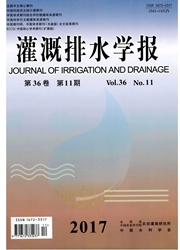

 中文摘要:
中文摘要:
已建大型灌区向城市引水是供水对象扩展问题,也是一个关系到区域社会、经济及生态等方面的多目标复杂系统优化问题。运用系统科学原理和方法,根据灌区供水结构调整的需要,基于系统仿真技术建立了灌区供水系统的多目标模拟模型,采用改进层次分析法将多目标问题转化为单目标函数,并提出试验遗传算法对该系统的设计参数和引水运行参数进行优化设计。通过某实际灌区的优化设计表明,该模型可以在保证城市需水要求的同时减小城市引水对农业灌溉的影响,从而提高灌区水资源的利用率,进一步发挥灌区水资源应有的经济效益和社会效益。
 英文摘要:
英文摘要:
With micro-lysimeters, experiments were conducted to investigate the evapotranspiration (ET) and growth pattern of turfgrass under different soil moisture conditions in 2002 to 2004. The turf grass was irrigated once a week or two weeks in 2002 and 2003, while in 2004 three lower limits of soil moisture content in the root zone were used as turf irrigation index. The three soil moisture content levels, which correspond to three water stress levels, were 80% ( S1 ), 60% ( S2), and 40% ( S3 ) of filed capacity(FC). All lysimeters in 2002 to 2004 were irrigated with different amounts such that the soil water content in the root zone was refilled to field capacity. Results indicated that ET for all turfgrasses has two peaks in each year. The fast peak appears from the middle of May to the end of Jun, while the second peak appears from the middle of July to the middle of September. ET of turf grass changes with precipitation. Highest growth for shoot and root was found for treatment S1, while there is approximately no significant difference in shoot and root growth between treatments S2 and S3. However, ET was significantly reduced with the decrease lower limit. It is recommended lower limit in the range 40% to 60% of FC is suitable in turfgrass irrigation practice to achieve the goal of water saving.
 同期刊论文项目
同期刊论文项目
 同项目期刊论文
同项目期刊论文
 The impact of rising international crude oil price on China’s economy: an empirical analysis with CG
The impact of rising international crude oil price on China’s economy: an empirical analysis with CG A scenario analysis of energy requirements and energy intensity for China’s rapidly developing socie
A scenario analysis of energy requirements and energy intensity for China’s rapidly developing socie Can market oriented economic reforms contribute to energy efficiency improvement? Evidence from Chin
Can market oriented economic reforms contribute to energy efficiency improvement? Evidence from Chin Forecasting flood disasters using an accelerated genetic algorithm: Examples of two case studies for
Forecasting flood disasters using an accelerated genetic algorithm: Examples of two case studies for The Empirical Study on Fractal Features and Long-run Memory Mechanism in the Petroleum Price Systems
The Empirical Study on Fractal Features and Long-run Memory Mechanism in the Petroleum Price Systems The effect of investor psychology on the complexity of stock market: An analysis based on cellular a
The effect of investor psychology on the complexity of stock market: An analysis based on cellular a Impact of speculator's expectations of returns and time scales of investment on crude oil price beha
Impact of speculator's expectations of returns and time scales of investment on crude oil price beha 期刊信息
期刊信息
